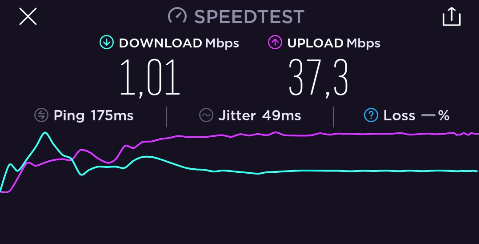Recently, I attended a huge fair with 10.000 people crammed into a 16.000 m2 hall that had indoor LTE coverage from 3 network operators and little Wifi for public use. From a mobile network point of view it doesn’t get much ‘worse’ than this so I spent some time to have a look how one of the networks was coping with such a huge number of people and their devices.
Author: Martin
LTE – When The Downlink Sucks
The Story and Sounds of the Voyager Golden Record
 A bit off topic perhaps but never mind: I was recently pointed to the website of ‘2000 Hertz’, a podcast on sound and music. Not really my domain but they recently had an episode on the sounds on Voyager 1 and 2’s golden records. I of course knew about the records and that Carl Sagen was one of the masterminds behind them but had little further background. This podcast episode magically mixes the sounds and stories behind the records and is an absolutely must hear for space enthusiasts. Enjoy!
A bit off topic perhaps but never mind: I was recently pointed to the website of ‘2000 Hertz’, a podcast on sound and music. Not really my domain but they recently had an episode on the sounds on Voyager 1 and 2’s golden records. I of course knew about the records and that Carl Sagen was one of the masterminds behind them but had little further background. This podcast episode magically mixes the sounds and stories behind the records and is an absolutely must hear for space enthusiasts. Enjoy!
How To Get Nationwide 5G Coverage and a 5G Core Network
So here we are in the fall of 2019. 5G networks have started around the globe and pretty much all of them use high-band spectrum at 3.5 GHz (band n78). US operators are experimenting with 2.5 GHz and mmWave spectrum in combination with an LTE anchor cell. The anchor cell is usually either at 1.8 GHz (band 3) or 2.6 GHz (band 7) and perhaps in some cases also on the 800 MHz low-band (band 20). That is all nice and well but 5G on 3.5 GHz won’t cut it when it comes to nationwide coverage. For that, 5G also needs to use the mid- and low-bands. But how do we get there?
Continue reading How To Get Nationwide 5G Coverage and a 5G Core Network
LTE TTI Bundling in the Wild
Already back in 2009 (!), I wrote a blog post on LTE’s TTI-bundling feature. It was supposed to be used to improve cell edge scenarios when a device’s uplink power would not be sufficient anymore. In particular it was seen to improve VoLTE speech quality. Quite a bit of thinking ahead because we were far away from VoLTE in practice back then. Over the years I haven’t seen TTI Bundling in the wild until recently.
My First Semi-Autonomous Drive Experience
When I was recently in the US, I had the opportunity to drive a Toyota RAV4 that came equipped with semi-autonomous driving features. A welcome opportunity to experience first hand over a few hours in dense metropolitan areas and overland routes the current state of driver assistance technology.
When Wideband Was 50 kbit/s
For months I am trying to get through an amazing book ‘The Dream Machine’, a biography of computing pioneer J. C. R. Licklider. The ‘problem’ with the book is that it is so packed with interesting stories about computing and networking from the 1950s to the 1980s, that there is hardly a page at which I don’t deviate to get some more background information. I am about halfway through and again got stuck when I started some background research on the early days of the Arpanet. This is when I stumbled over an incredibly interesting video I thought I should mention here.
USB Speed – Cheat Sheet
Over the years, USB had been upgraded and upgraded and upgraded and it’s easy to loose sight of how fast in theory and in practice a particular version of the USB standard could be. So here’s a quick cheat sheet with the theoretical maximum speed of different USB versions:
Some Thoughts On The Advent of Word Processing
I can still remember that as a teenager in the 1980s I used a typewriter for school and to document things. This was the time before I got my first home computer and printer after which I don’t think I used the typewriter much if at all anymore and did all of my ‘word processing’ on my C64 and attached needle printer. I can hardly imagine how it must have been before that time when people wrote books and other long documents without this truly revolutionizing functionality.
But when did this all start? After all, when I started to use word processing on a home computer, it was already a mass market application. So I started to investigate a bit.
Continue reading Some Thoughts On The Advent of Word Processing
3GPP Specification Bloat
When I’m looking into the specs to get some details on basic LTE features, I tend to look at ‘old’ 3GPP specification documents as more often than not, things are much easier to find there than in the latest and greatest versions of the same document. Here’s an interesting example: 3GPP 36.133 on LTE Radio Resource Management. In 3GPP Release 8, which is one version after the initial Rel. 7 LTE specification and published in 2013, the document has 339 pages. The current Release 15 version published in July 2019 has 3602 pages. Woah!
